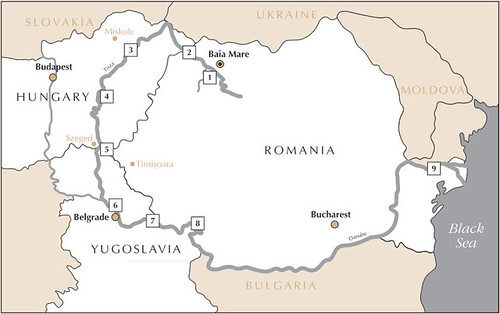The Baia Mare area received approximately 120 mm of snowfall and 40 mm of rain from mid-December until the end of January. On January 30, 2000, due to the precipitation in the area the dam crest was flooded and over 25 meters of the dam wall was washed away.
Contributing Factors
- Insufficient safety evaluation during the financing process
- Processing plant and tailings facility design shortcomings
- Lack of contingency planning and emergency preparedness
- Ineffective enforcement and inspection by regulatory agencies
- Inadequate chemical handling procedures
- Lack of awareness of hazards by potentially affected communities and authorities
(Source: UNEP, The Regional Environmental Center for Central and Eastern Europe)
January 30, 2000
Cyanide sill occurs in Baia Mare, Romania [1].
11pm - Aurul notifies local EPA and shuts down activity, starts to close breach.
31 January 2000
Notification of local and national authorities in Romania and downstream trans-boundary authorities in Hungary, Serbia, Bulgaria.
Treatment of spillage with hypochlorite.
1 February 2000
Spill plume reaches Romanian-Hungarian border [2].
Experts of the Dam Commission arrive.
2 February 2000
Spillage stopped and decontamination started.
Dead fish reported at Satu Mare.
5 February 2000
Cyanide registers in tests at Tiszalök [3].
8 February 2000
Romania and Hungary meet ministers of environment.
9 February 2000
Spill plume reaches Szolnok [4].
11 February 2000
Spill plume crosses Hungarian-Yugoslavian border [5].
13 February 2000
The plume reaches Belgrade, Yugoslavia [6].
15 February 2000
The plume meets the Romanian border again, at Ram [7].
17 February 2000
Cyanide shows up in tests at Iron Gate, Romania [8].
EU, Romania and Hungary meet and visit by EU Commissioner for Environment Margaret Wallström.
25 February 2000
United Nation Environmental Programme (UNEP) and the Office for the Co-ordination of Humanitarian Affairs (OCHA) Mission starts assessment work.
25-28 February 2000
The plume reaches the Danube delta [9].
March 2000
UNEP/OCHA Mission Report.
Government Response
In Romania, about ten hours were lost between the time the Baia Mare Environmental Protection Agency received notification of the spill from Aurul and the time the local Romanian Waters Authority was informed. As a result, local residents near the source of the spill were not informed as early as possible.
Once the Romanian Water Authority was informed, however, their regional environment and water authorities immediately checked information about the breach and the spill to determine the degree of pollution, and ordered Aurul to stop activities and close the breakage. They also informed the Water and Environmental Protection Agency of Hungary about the accident, and alerted local authorities downstream about the spill and dangers in using the river water for activities such as drinking. The Romanian Principal International Alert Center (PIAC) notified the Hungarian PIAC on January 31 at 20:54. It also informed Bulgaria, Moldova, Ukraine and former Yugoslavia. According to international law, PIACs must be informed as soon as there is a sudden increase of hazardous substances in the Danube River Basin. The mission found that this early warning system responded adequately to the spill.
Hungarian authorities confirmed that they were continuously informed about the event and the degree of pollution by Romanian authorities. This allowed them to alert all regional and local authorities in a timely manner and to take the necessary measures to minimize the impact of the spill.

